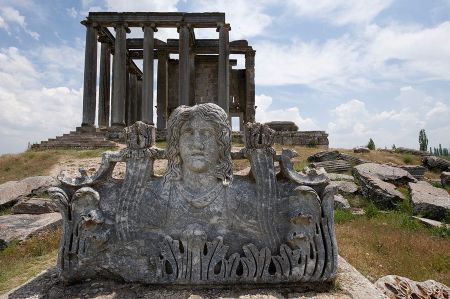Aizanoi - Roman metropolis near Kütahya
- Written by Portal Editor
We were on our way to the well-known porcelain exhibition of Kütahya (a separate report will follow later), the provincial capital of the eponymous province of Kütahya with 214,000 inhabitants, which had been hit by strong earthquakes in 1896, 1930, 1944 and 1970. The last major earthquake alone killed 1,100 people.
Coming from Afyonkarahisar on the D 650, we were crossing the plains of the Anatolian highlands at about 930 meters above sea level when we came across the signs pointing to the ancient city of Aizanoi. It is already known from the approximately 5,000-year history of the city of Kütahya that there has also been an interplay of different population groups here. In addition to the Hittites and Phrygians, the Persians and Macedonians settled here, as did the Romans, the Byzantines, the Seljuk Sultanate, the Armenians, the Greeks, the Germiyans and the Ottomans later.
The Greco-Roman city of Aizanoi
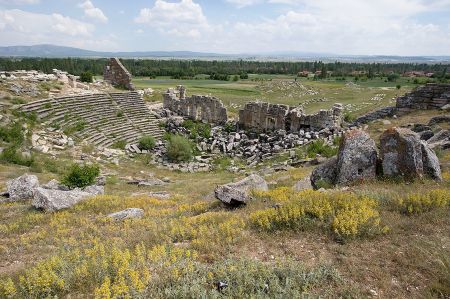 About 50 kilometers southwest of Kütahya in the area of the Turkish country town of Çavdarhisar is the ancient Greek-Roman city of Aizanoi, which is of particular relevance as an extensive ruin site due to the very well-preserved Zeus Temple from the time of Emperor Domitian (81 - 96 AD). . Already in the years 1926 and 1928 the first excavations were carried out by Messrs. D. Krenker and M. Schede on behalf of the DAI. Since the 1970s, further excavations have been carried out in cooperation with the University of Freiburg under the direction of Prof. R. von den Hoff. Some of the excavation sites in the extensive fields of ruins are in the middle of the original old Turkish village with its really atmospheric farmsteads of the current residents.
About 50 kilometers southwest of Kütahya in the area of the Turkish country town of Çavdarhisar is the ancient Greek-Roman city of Aizanoi, which is of particular relevance as an extensive ruin site due to the very well-preserved Zeus Temple from the time of Emperor Domitian (81 - 96 AD). . Already in the years 1926 and 1928 the first excavations were carried out by Messrs. D. Krenker and M. Schede on behalf of the DAI. Since the 1970s, further excavations have been carried out in cooperation with the University of Freiburg under the direction of Prof. R. von den Hoff. Some of the excavation sites in the extensive fields of ruins are in the middle of the original old Turkish village with its really atmospheric farmsteads of the current residents.
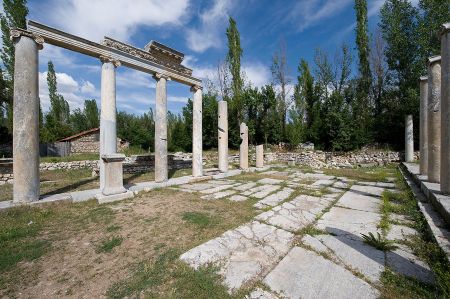 There is also a settlement mound from the early Bronze Age with remains of Hellenistic settlements. The settlement of Aizanoi with its traces from the Iron Age, Hellenistic and early Roman times was expanded into a city by the Romans. Baths, a theatre, the stadium, bridges and squares as well as the already mentioned Zeus temple were built during the imperial period.
There is also a settlement mound from the early Bronze Age with remains of Hellenistic settlements. The settlement of Aizanoi with its traces from the Iron Age, Hellenistic and early Roman times was expanded into a city by the Romans. Baths, a theatre, the stadium, bridges and squares as well as the already mentioned Zeus temple were built during the imperial period.
Around 200 BC the area in which Aizanoi is located came to the kingdom of Pergamon as Phrygia epiktetos (“additionally acquired Phrygia”); for a time the city also belonged to Bithynia. The kings of Pergamon settled here mercenaries who probably came from Macedonia. After 133 BC, the city and its entire empire became part of the Roman province of Asia.
Romans built two bridges over the Pekala
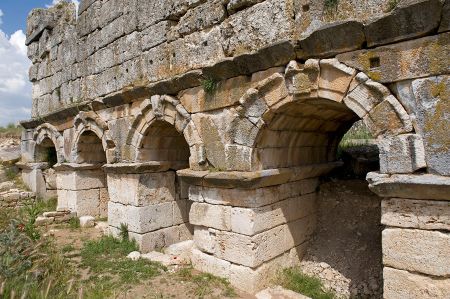 Named Pekalas in ancient times, the river once ran through the city center and was spanned by three bridges built by the Romans. Aizanoi is located in the valley of the Pekalas, which is now called Kocaçay and is one of the source rivers of the Rhyndakos. Two of these bridges from the year 157 AD are still open to traffic today, albeit modernized to reflect Turkish construction. These bridges alone are definitely worth the trip. Around the middle of the 1st century AD a temple of Artemis Hagiotate was built. Other attractions of the ancient city of Aizanoi also include the two thermal baths, the theatre, the stadium and the necropolis. Further to the east of the settlement area and above the river is the cult cave of the Meter Steunene, which is already mentioned by Pausanias in his notes.
Named Pekalas in ancient times, the river once ran through the city center and was spanned by three bridges built by the Romans. Aizanoi is located in the valley of the Pekalas, which is now called Kocaçay and is one of the source rivers of the Rhyndakos. Two of these bridges from the year 157 AD are still open to traffic today, albeit modernized to reflect Turkish construction. These bridges alone are definitely worth the trip. Around the middle of the 1st century AD a temple of Artemis Hagiotate was built. Other attractions of the ancient city of Aizanoi also include the two thermal baths, the theatre, the stadium and the necropolis. Further to the east of the settlement area and above the river is the cult cave of the Meter Steunene, which is already mentioned by Pausanias in his notes.
Contacts between Aizanoi and the metropolis of Pergamon have been proven since the late 3rd century BC. With the gradual expansion of the city on both banks of the Pekalas and above all with the construction of the Ionian temple in honor of Emperor Domitian and the temple dedicated to Zeus, Aizanoi itself became a metropolis. The sanctuary of Zeus, the main god of the city, was built in the shape of a pseudodipteros. On the walls of the cella are the remains of extensive inscriptions from the time of Emperor Hadrian, which refer to the land holdings of the sanctuary. Noteworthy is the underlying barrel vault with light windows, which probably served as a cult room.
Eurycles - Emissary to the Panhellenion in Athens
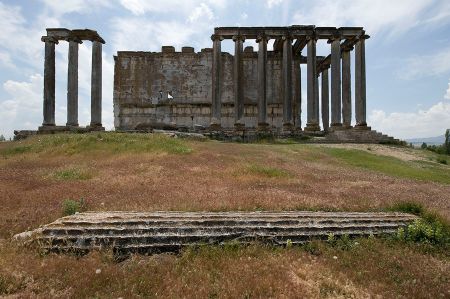 The stadium and theater are of quite unusual construction and are connected to each other. An unusual constellation for Roman architecture. In addition, individual construction phases in the theater can be seen quite clearly. We know from records that a few rich families in particular made an effort to expand the city, including Ulpius Appuleianus Flavianus and his son Ulpius Appuleius Eurycles. Eurycles was also an emissary to the Panhellenion in Athens, which Hadrian had set up. During this time, a large bath and gymnasium complex was also built, as well as a water pipe that probably led there. Other public buildings included a rotunda that served as a macellum (market building) and to which was attached a copy of Diocletian's maximum price edict.
The stadium and theater are of quite unusual construction and are connected to each other. An unusual constellation for Roman architecture. In addition, individual construction phases in the theater can be seen quite clearly. We know from records that a few rich families in particular made an effort to expand the city, including Ulpius Appuleianus Flavianus and his son Ulpius Appuleius Eurycles. Eurycles was also an emissary to the Panhellenion in Athens, which Hadrian had set up. During this time, a large bath and gymnasium complex was also built, as well as a water pipe that probably led there. Other public buildings included a rotunda that served as a macellum (market building) and to which was attached a copy of Diocletian's maximum price edict.
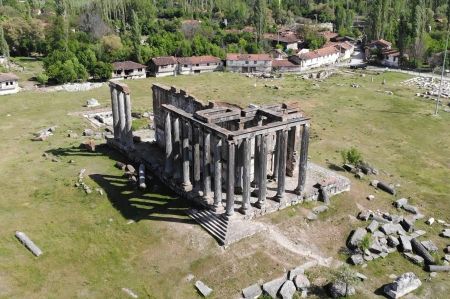 To regulate the flow behavior of the Pekalas, a dam was built east of Aizanois by Roman hydraulic engineering experts as early as Roman times. In the 5th century, when Aizanoi rose to become a bishop's seat, a street of columns was built from ancient buildings that had been removed and are now partially reconstructed.
To regulate the flow behavior of the Pekalas, a dam was built east of Aizanois by Roman hydraulic engineering experts as early as Roman times. In the 5th century, when Aizanoi rose to become a bishop's seat, a street of columns was built from ancient buildings that had been removed and are now partially reconstructed.
In the 11th century a Byzantine fortress was built on the ruins of the ancient temple courtyard, but it only survived for a few years. Again, large amounts of building material were taken from the remains of the ruins. It was only in 1824 that science recognized that the Ottoman town of Çavdarhisar must be ancient Aizanoi. However, it was only around 100 years later that the excavations began in a scientifically sound manner.
For your travel planning:
39°11'41.766"N, 29°37'49.9296"E
Please read as well:
